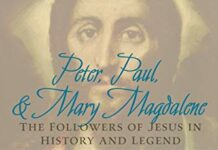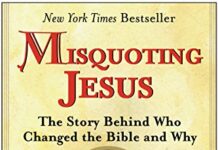
Ebook Info
- Published: 2012
- Number of pages: 641 pages
- Format: PDF
- File Size: 6.65 MB
- Authors: Bart D. Ehrman
Description
“Arguably the most distinctive feature of the early Christian literature,” writes Bart Ehrman, “is the degree to which it was forged.” The Homilies and Recognitions of Clement; Paul’s letters to and from Seneca; Gospels by Peter, Thomas, and Philip; Jesus’ correspondence with Abgar, letters by Peter and Paul in the New Testament–all forgeries. To cite just a few examples.Forgery and Counterforgery is the first comprehensive study of early Christian pseudepigrapha ever produced in English. In it, Ehrman argues that ancient critics–pagan, Jewish, and Christian–understood false authorial claims to be a form of literary deceit, and thus forgeries. Ehrman considers the extent of the phenomenon, the “intention” and motivations of ancient Greek, Roman, and Jewish forgers, and reactions to their work once detected. He also assesses the criteria ancient critics applied to expose forgeries and the techniques forgers used to avoid detection. With the wider practices of the ancient world as backdrop, Ehrman then focuses on early Christian polemics, as various Christian authors forged documents in order to lend their ideas a veneer of authority in literary battles waged with pagans, Jews, and, most importantly, with one another in internecine disputes over doctrine and practice. In some instances a forger directed his work against views found in another forgery, creating thereby a “counter-forgery.” Ehrman’s evaluation of polemical forgeries starts with those of the New Testament (nearly half of whose books make a false authorial claim) up through the Pseudo-Ignatian epistles and the Apostolic Constitutions at the end of the fourth century.Shining light on an important but overlooked feature of the early Christian world, Forgery and Counterforgery explores the possible motivations of the deceivers who produced these writings, situating their practice within ancient Christian discourses on lying and deceit.
User’s Reviews
Reviews from Amazon users which were colected at the time this book was published on the website:
⭐I like the book, but disappointed in the format via Audible.com.I do not know the credentials of the reader, but his pronunciation seemed often a bit strange, especially for names of ancient writers, and certainly different from the way Ehrman pronounces their names. His timing, pacing, and interpretation are also a bit lacking, though arguably accurate in some instances (e.g. reading 2 Peter as “two Peter” rather than “second Peter,” the latter more typical in the reading of Christian literature.).I’ll not insult you by commenting on the book as a format, and I’ll assume that you are similarly familiar with audio books on CDs, but if you are not familiar with audio books as “.aa” files, then you might benefit from the following.You will likely receive your audio book in one or more 6-hour audio files, perhaps separated by chapters, and amenable to starting at a chapter, but playing all the way to the end.If you wish to listen to a particular chapter, and not go on to the following chapters, you will need to purchase the audio on CDs or use what I assume to be an illegal procedure to deconstruct the “.aa” files into smaller units, such as an mp3 file for each chapter. Costly and labor intensive even if it were legal, which I suspect is not.Such limited listening options led me to terminate my brief venture with Audible.com.Incidentally, I confirmed the aforementioned limitation with an Audible.com representative, after which they realized that they had little argument for my continuing my subscription.Otherwise, for many, it appears to be a desirable service.
⭐Professor Ehrman needs no endorsement as a great scholar nor is there any doubt about the thoughtfulness of his analysis or conclusions. Instead, I will simply address the one issue that seems to concern other reviewers — the accessibility of this book to the non-specialist. First, I note that he has published a lighter version of this book — “Forgery” — that is specifically intended for the more casual reader. That does not, however, mean that this book is of value only to specialists. I found the book to be well-written, clearly argued, and free of jargon. The biggest difference is that the arguments are developed in detail rather than just sketched out. This may require more patience from the reader, but the reward is being able to actually see the analysis rather than just getting a descriptive overview.Therein, I think, lies the point of decision. If you prefer an overview with some examples, then the shorter version is the right choice and you will get the gist of the analysis. If you would like a point-by-point detailed exposition, then this is the book for you, and no specialist knowledge is really required.
⭐Not the easiest read since it is one of his books geared for academics. This one is published by Oxford University Press. If you are a casual reader, I would recommend looking for his books published by Harper or Simon and Schuster. I hear his book ‘Forged’ is a much more condensed version of this book for the average reader. Acorrding to Bart this is the book he is most proud of. If your into collecting, I would snag it!
⭐One of Ehrman’s better books. Huge lift, and best used as a reference for the many writings it covers. I was surprised to see Ehrman say the apostle Paul was not a misogynist, as I usually think of Ehrman as, at best, uninterested in women, and, at worse, taking for granted without any rhetorical analysis some of the “Fathers” diatribes against women. In this book, however, he shifts. His analysis of the Statutes of the Apostles as a reaction early Christian women priests is excellent. This type of analysis of the traditions of Second Temple Judaism with respect to women within early Christianity would make a great book on its own.
⭐Bart Ehrman has written a number of interesting books on the New Testament and early Christianity. I’ve found these books to be enlightening even if I don’t always agree with his conclusions. Those of Ehrman’s books that I have read to his point have been aimed at the average reader — successfully aimed, because they have sold very well and made Ehrman perhaps the best-known writer on these topics. This book summarizes his scholarly research on a topic that he has also discussed at length in his popular books: The New Testament books that claim to be written by someone other than their actual authors (in this book he expands the discussion to include other early Christian writings in addition to those that appear in the New Testament). Ehrman has been forthright in labeling these books forgeries because he argues — correctly, I think — that the authors were trying to deceive their readers by claiming to be the Apostle Paul, the Apostle Peter, or another revered person. Other scholars have been reluctant to use the word “forgery” for these documents, but I think Ehrman is justified in doing so.This book is aimed at a scholarly audience, so I assume that Ehrman expects most readers to be academics or graduate students. Although the result is a more densely written book, I didn’t find it to be any more difficult to understand than his popular books. Ehrman notes that he was talked out of reproducing quotes in the documents’ original languages. Had he done so, he would have lost at least this reader! Ehrman’s arguments make for interesting reading and I found them to be convincing. I particularly profited by his discussion of the reasons for the “I/we” passages in Acts. So, although the book is definitely a harder and somewhat dryer read than his popular books, anyone with a strong interest in the subject matter should be able to get through it.I do have one serious issue with the book: The binding is terrible. You would think that Oxford University Press when publishing a book aimed at a scholarly audience would use a sewn binding that would enable the book to lie flat. Unfortunately, they didn’t; the binding is glued, making the book very difficult to open completely without cracking the binding. As leisure reading, the shoddy construction of the book was annoying but no more than that. But if I was a professor or grad student carefully studying the book and perhaps copying out passages from it, I would be upset that the book will not lie flat. No real excuse for a major university press to produce a book with this glaring shortcoming.
⭐Ehrman wrote mani books on this subject; this list the biggest and the most documented, with a scholar approach.
⭐A groundbreaking work with severe implications for the authority of Scripture.
⭐through and deep study of huge scholarship, an invaluable resource for theologians
⭐This is the scholarly version which he promised to deliver in his earlier book, Forged, and for me it does not disappoint, it was well worth the wait. In fact, I wish that I had been able to read such a book years ago so that I would have engaged the issues raised much earlier in life.Though this book is directed at scholars, I predict that it will be useful to and appreciated by non-scholars who have some familiarity with the issues concenring Early Christian Origins, espeically the development of the “Christian canon” which took place during, at least, the first four centuries of Christianity, hence the reader will have to engage many non-canonical and some non-Christian works.When Ehrman quotes foreign language materials, mostly German, with some French and Latin, he gives the English translation in the main text, and the original in a footnote, while most ancient texts are in English translation with the original language to be looked up elsewhere. However, there are times when he does not translate minor bits of Greek which those readers without Greek will have to pass over and so some readers may find that frustrating, but I doubt very much that it will detract from their understanding of his argument.The bibliography, and indicies (ancient sources and subjects) meet expectations, and as noted above he uses footnotes rather than endnotes which makes the reading of the text so much easier when following his references.It is difficult to read this book straight through, requiring a major investment of time and reflection, and I suspect that some of the (annoying?) minor repetition of key points points is due to an editorial assumption that most people will read this book in bits and pieces.I will leave off engaging in any technical arguments for scholarly reviews elsewhere, but I think that the careful reader would do well to think about potential logical fallacies as she reads, in particular the fallacies of arguing from the part to the whole, and its reverse from the whole to the part.Also, I predict that some readers will be very upset with what he has to say, while some others will absolutely love his overall arguments and agree with the assertion that forgery, that is lying, is part and parcel of the Christian canon and that this has significant implications for the Christian faith.Hence, if one already thinks that Ehrman “is out to push the buttons of evangelicals and fundamentalists” – however, I think that a larger group of Christians will be unsettled by his arguments – then I do not think that too much in here will surprize a person, but can an effective counter to his charges of forgery, lying and deceit built right into the New Testament be made by those arguing for an essentially orthodox position??!!
⭐This work should not be confused with “Forged: Writing in the Name of God.” Unlike “Forged,” “Forgery and Counterforgery is a scholarly, academic, and advanced look at the practice of forgery in the NT and early Christian literature. The style is very different than Ehrman’s NY Time’s bestsellers (Forged: Writing in the Name of God; Misquoting Jesus; God’s Problem; Jesus, Interrupted). It assumes an advanced knowledge of New Testament scholarship and issues. It’s extremely comphrensive and makes a convincing case for calling falsely attributed/pseudepigraphic books in the NT and early Christian literature “forgery,” looks at why certain NT and early Christian works are considered forged, and the broader phenomenon in Greek and Roman world. Strong engagement with scholarship with extensive footnotes. Yet it is very readable. Advances scholarly conversation regarding the practice of forgery in an original way. It is well-argued and detailed (over 600 pages). If you are looking for an introductory treatment look at his trade book “Forged: Writing in the Name of God.”
⭐Forged: Writing in the Name of God–Why the Bible’s Authors Are Not Who We Think They Are
Keywords
Free Download Forgery and Counterforgery: The Use of Literary Deceit in Early Christian Polemics 1st Edition in PDF format
Forgery and Counterforgery: The Use of Literary Deceit in Early Christian Polemics 1st Edition PDF Free Download
Download Forgery and Counterforgery: The Use of Literary Deceit in Early Christian Polemics 1st Edition 2012 PDF Free
Forgery and Counterforgery: The Use of Literary Deceit in Early Christian Polemics 1st Edition 2012 PDF Free Download
Download Forgery and Counterforgery: The Use of Literary Deceit in Early Christian Polemics 1st Edition PDF
Free Download Ebook Forgery and Counterforgery: The Use of Literary Deceit in Early Christian Polemics 1st Edition





